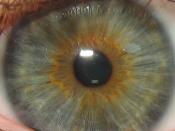Computerized billboards that know your name, voice controlled house appliances, floating cars, and eye scanners. Besides being some of the key technologies of the future in Steven SpielbergÃÂs 2002 film, Minority Report, what else do these technologies have in common? A level of absurd science fiction; or the incredible fact that they are all currently scientific works in progress? While many technologies presently undergoing research, such as voice controlled house appliances, are primarily for human convenience, others, like the eye scanner, are being pushed for heavily by many governments and companies world wide. WhatÃÂs even more intriguing regarding the technology of eye scans is the controversy behind its use. How exactly does it work? How do governments plan to implement the technology? Is it safe? Basically, what is it all about? While many are opposed to using eye scanning technology for a plethora of reasons, there are also many who support the idea and offer sufficient evidence to prove its necessity in todayÃÂs rapidly evolving society.
With the ever growing concerns over national security, immigration and border control, as well as plain old identity theft, many governments including the United Kingdom and United States are seriously considering the implementation of biometric technology as a new source of identification and security. As reported by Jo Twist, a BBC News Online technology reporter, Biometric technology, simply put, is the recording of ÃÂunique physiological characteristicsÃÂ specific to an individual. Twist describes the three main biometric technologies as iris, face, and, fingerprints.
In SpeilbergsÃÂ Minority Report, we see the constant use of high-tech facial scanning, lasers tracking over peoplesÃÂ eyes, and an array of other ÃÂbiometric securityÃÂ methods. Fortunately, or unfortunately, depending on which side one takes, the technologies seen in the movie arenÃÂt all that impressive or hard to explain. In fact,


